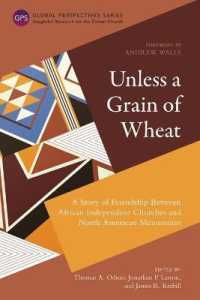- ホーム
- > 洋書
- > 英文書
- > Science / Mathematics
Full Description
In recent years public awareness of the long term toxic affects heavy metal ions in waters and wastewaters has increased significantly. Environmental agencies have been imposing more and more stringent discharge limits on industries involved in processes using metal ions. Numerous industries produce aqueous effluents con taining metal ions and particularly copper and cadmium. Copper sulfate is used on a large scale in the electroplating industries. In addition, copper salts are used as fungicides, timber preservatives, insecticides, paint corrosion inhibitors and in dyestuffs. Cadmium is used in the manufacture of nickel-cadmium batteries, as a corrosion inhibitor and control rods in the nuclear industry. The European Com munity has listed cadmium as one of the most dangerous metal due to its toxicity, persistence and bioaccumulation in List 1 of its Directive 76/464/EEC. Therefore, it is important that methods for the removal of these metal ions are found and that the mechanism of removal is characterized and understood. A number of adsorb ents have been identified which are capable of removing copper (Panday et aI. , 1985; Ho et aI. , 1996; Low and Lee, 1987; Low et aI. , 1993; Quek et aI. , 1998) and cadmium (Battacharya and Venkobachar, 1984; Namasivayam and Ranganathan, 1995; Periasamy and Namasivayam, 1994) from aqueous solutions. Sorption kin etic models have been proposed for some systems.
Contents
1. Bioaccumulation of Yttrium: A Microbial Model for the Management of Nuclear Wastes.- 2. The Removal of Metal Ions from Aqueous Solutions by Bone Char Sorption.- 3. Fermentation Parameters in Solid State Fermentation of Streptomyces sp. Cultured on Chitin.- 4. Characterizing the Role of Bacteria and Bacterial Activities in the Emulsification and Degradation of Triglycerides.- 5. The Influence of Pseudomonas putida CP1 on the Degradation of Mono-Chlorophenols by a Mixed Microbial Population.- 6. The Use of Immobilised Rhizopus oryzae as a Biosorbent for Reactive Dye and Metal Ions.- 7. The Deterioration of Biodegradable Plastic Films and Fishing Lines by Microorganisms in Soil, Sewage, and Sea Water.- 8. Broad Spectrum Decolorizing Bacterial Strains and Their Functional Plasmids.- 9. Degradative Potential of Microorganisms from DDT-Contaminated Soils.- 10. Estimation of Nitrogen Requirement in Peat and Perlite Biofilters Removing Hexane from Air.- 11. The Production of Various Adsorbents from Lignite, and the Thermal Conductivity of the Optimum Adsorbent under Methane at Low Pressures.- 12. Ion-Exchange Removal of Ammonium Ions from Secondary Treatment Wastewaters and Dilute Solutions Using Clinoptilolite.- 13. Characteristics and Mechanisms of Mercury Resistance of the Anaerobic Bacteria Isolated from Mercury Polluted Sea Bottom Sediment.- 14. Photocatalysis for Pretreatment of Metal-Containing Samples and for Removing Metals from the Waste.- 15. Molecular Genetics of Bacterial Polyphosphate Accumulation to Better Understand the Mechanism Underlying Biological Phosphorus Removal.- 16. The Influence of Environmental Conditions on the Ability of a Mixed Microbial Population to Degrade 4-Chlorophenol.- 17. Immobilised Enzymes: Characterisation and Functional Meaning in Soil Amendments of Organic Wastes.- 18. Biocontrol of Cellulose Wastes Pollution Using Immobilized Fungi on Complex Polyhydrogels.- 19. Seasonal Variations in Spectral Reflectance of Microbial Flocculates, Precipitates, and Oil-Like Films Associated with Neutral and Acidic Mine Drainage.- 20. Evaluation of Ecotoxicological Effects of Diaryl Ethers on Green Algae.- 21. Effects of Culture Temperature on the Quality of Compost during Curing Stage.- 22. Remediation of Chlorinated Hydrocarbon Solvents.- 23. Microbiological and Chemical Methods for Decolorization of Molasses-Derived Alcohol Distillery Effluent.- 24. A Robust Model for Wastewater Treatment in Sequencing Batch Reactors.- 25. Primary Treatment Options for Fish Processing Effluent in Ireland: Pilot Scale Trials of Physicochemical and Biological Treatments.







